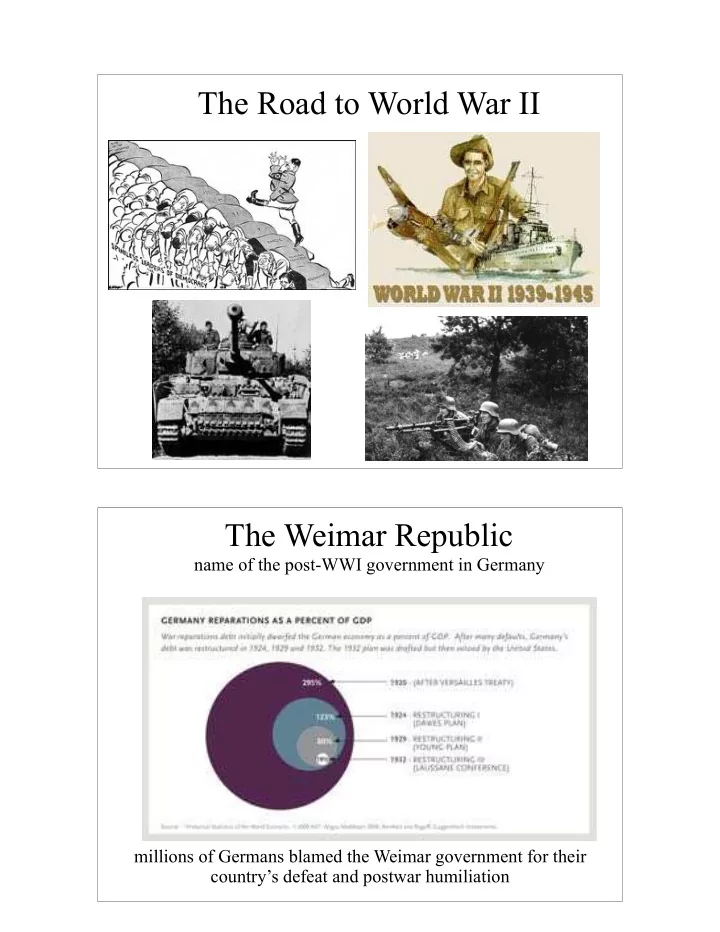

The Road to World War II The Weimar Republic name of the post-WWI government in Germany millions of Germans blamed the Weimar government for their country’s defeat and postwar humiliation
Inflation Causes Crisis in Germany Heavy reparations payments caused the value of the Reichsmark to fall sharply, causing severe inflation. Germans needed more and more money to buy the most basic goods. In Berlin a loaf of bread cost less than a mark in 1918, more than 160 marks in 1922, and some 200 billion marks by late 1923. The Dawes Plan American banks loaned money to Germany Germany’s reparations payments were restructured
The Kellogg-Briand Pact in 1928, US Secretary of State Frank Kellogg arranged an agreement that pledged “to renounce war as an instrument of national policy” almost every country in the world signed the treaty the treaty had no means to enforce its provisions 1929 American Financial Collapse in September 1929, some many middle- investors income people started selling began buying their stocks stocks on panic ensued; margin prices plunged to a new low on “Black Tuesday,” October 29, 1929, the Stock Market collapsed
A Global Depression American bankers demanded repayment of loans US placed high tariffs on imported goods World trade dropped by 65%. Unemployment rates soared. The Failures of Versailles • Germany’s economy was in a shambles • The Versailles Treaty failed to provide a “just and secure peace” as promised • Instead Germany grew more and more resentful of a treaty they felt was too harsh and too punitive The Versailles Treaty (above on crutches) took a beating in the U.S. and abroad
Adolf Hitler • WWI veteran • joined a the German Workers’ Party in 1919 Hitler in WWI, far right • Hitler had great public speaking abilities and in organizing support • he quickly become a leader of the group, renaming it the National Socialist German Workers’ Party, or Nazi Party • In his book, Mein Kampf (My Struggle), he explained that he wanted to unite all German-speaking people in one grand Empire • He wanted racial purity – “inferior” races such as Jews, Slavs and all non-whites were to form a work force for the “master race” of blond, blue-eyed “Aryans” Hitler Gains Power By 1932, the Nazis were the strongest political party in Germany In January of 1933, Hitler was appointed as Germany’s Chancellor Hitler quickly threw out Germany’s existing government and replaced it with a totalitarian government Called himself “Der Führer” and his rule of Germany the Third Reich He promised to return Germany to its former glory.
Germany Rearms Above: Hitler is enthusiastically greeted as he visits a factory. Many Germans were grateful for jobs after the misery of the depression years. Germany Remilitarizes the Rhineland March 1936 The Rhineland was the region of Germany that was ‘demilitarized’ after the Treaty of Versailles.
Nazi Germany Expands: Austria Another element of Hitler’s grand design was creating “Lebensraum” In March, 1938, German troops marched into Austria unopposed. The arrival of German troops was met with great enthusiasm by the Austrians. The majority of Austrians favored unification with Germany A day later, Germany announced its union with Austria, which it called “Anschluss” Nazi Germany Expands: the Sudetenland many German-speaking people lived in the Sudetenland in Czechoslovakia 1938 - Hitler occupied the Sudetenland an occupation of the rest of Czechoslovakia seemed imminent
The Munich Conference September 1938 Hitler promised the annexation of the Sudetenland would be his “last territorial demand” the Munich Agreement allowed Germany to keep the Sudetenland Chamberlain returned to England and announced that he had secured “…peace in our time.” Neville Chamberlain, Edouard Daladier, Adolf Hitler, Benito Mussolini the dangerous policy of appeasement – giving up principles to pacify an aggressor Nazi Expansion Continues March 15, 1939: German troops occupy all of Czechoslovakia August of 1939: Germany and the USSR sign a non-aggression pact September 1, 1939: Germany invades Poland The Soviets received part of Poland (a promise made in the non- aggression deal between Germany and the USSR). Great Britain and France, allies of Poland, declared war on Germany. World War II had officially begun.
Recommend
More recommend